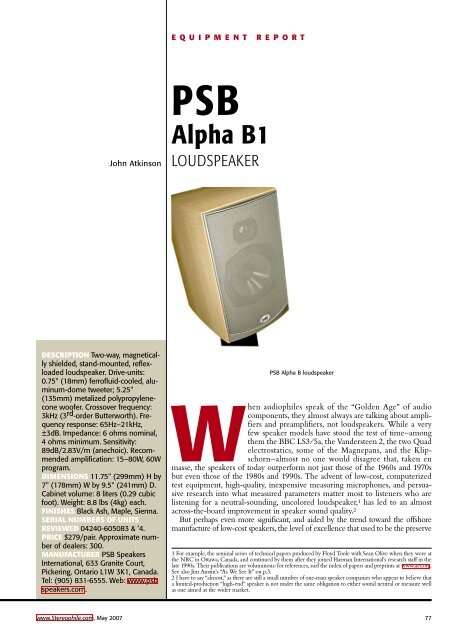home entertainment 2007
home entertainment 2007
home entertainment 2007
Create successful ePaper yourself
Turn your PDF publications into a flip-book with our unique Google optimized e-Paper software.
John Atkinson<br />
DESCRIPTION Two-way, magnetically<br />
shielded, stand-mounted, reflexloaded<br />
loudspeaker. Drive-units:<br />
0.75" (18mm) ferrofluid-cooled, aluminum-dome<br />
tweeter; 5.25"<br />
(135mm) metalized polypropylenecone<br />
woofer. Crossover frequency:<br />
3kHz (3 rd -order Butterworth). Frequency<br />
response: 65Hz–21kHz,<br />
±3dB. Impedance: 6 ohms nominal,<br />
4 ohms minimum. Sensitivity:<br />
89dB/2.83V/m (anechoic). Recommended<br />
amplification: 15–80W, 60W<br />
program.<br />
DIMENSIONS 11.75" (299mm) H by<br />
7" (178mm) W by 9.5" (241mm) D.<br />
Cabinet volume: 8 liters (0.29 cubic<br />
foot). Weight: 8.8 lbs (4kg) each.<br />
FINISHES Black Ash, Maple, Sienna.<br />
SERIAL NUMBERS OF UNITS<br />
REVIEWED 04240-605083 & ’4.<br />
PRICE $279/pair. Approximate number<br />
of dealers: 300.<br />
MANUFACTURER PSB Speakers<br />
International, 633 Granite Court,<br />
Pickering, Ontario L1W 3K1, Canada.<br />
Tel: (905) 831-6555. Web: www.psb<br />
speakers.com.<br />
EQUIPMENT REPORT<br />
PSB<br />
Alpha B1<br />
LOUDSPEAKER<br />
PSB Alpha B loudspeaker<br />
When audiophiles speak of the “Golden Age” of audio<br />
components, they almost always are talking about amplifiers<br />
and preamplifiers, not loudspeakers. While a very<br />
few speaker models have stood the test of time—among<br />
them the BBC LS3/5a, the Vandersteen 2, the two Quad<br />
electrostatics, some of the Magnepans, and the Klipschorn—almost<br />
no one would disagree that, taken en<br />
masse, the speakers of today outperform not just those of the 1960s and 1970s<br />
but even those of the 1980s and 1990s. The advent of low-cost, computerized<br />
test equipment, high-quality, inexpensive measuring microphones, and persuasive<br />
research into what measured parameters matter most to listeners who are<br />
listening for a neutral-sounding, uncolored loudspeaker, 1 has led to an almost<br />
across-the-board improvement in speaker sound quality. 2<br />
But perhaps even more significant, and aided by the trend toward the offshore<br />
manufacture of low-cost speakers, the level of excellence that used to be the preserve<br />
1 For example, the seminal series of technical papers produced by Floyd Toole with Sean Olive when they were at<br />
the NRC in Ottawa, Canada, and continued by them after they joined Harman International’s research staff in the<br />
late 1990s. Their publications are voluminous: for references, surf the index of papers and preprints at www.aes.org.<br />
See also Jim Austin’s “As We See It” on p.3.<br />
2 I have to say “almost,” as there are still a small number of one-man speaker companies who appear to believe that<br />
a limited-production “high-end” speaker is not under the same obligation to either sound neutral or measure well<br />
as one aimed at the wider market.<br />
www.Stereophile.com, May <strong>2007</strong> 77

















